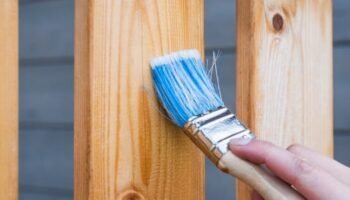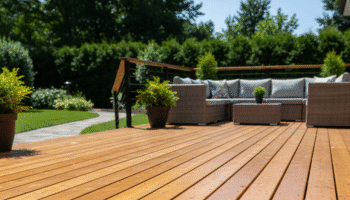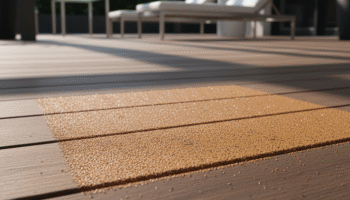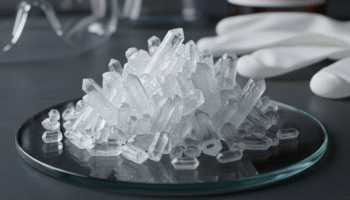Penetrating vs Film-Forming, Real-World Tests, and the Longest-Lasting Picks
If you’re choosing the best wood fence stain for 2025, start with the debate that actually decides longevity: penetrating oil-based stains vs film-forming (surface) finishes. After staining thousands of linear feet and stripping hundreds of failed film finishes, here’s the short story: on vertical fencing, penetrating stains win about 95% of the time—they move with the wood, don’t peel, and make re-coats painless. Film finishes can look great on day one, but they’re the ones I’m paid to strip off 12–24 months later when micro-cracks let water in and the peeling starts.
This guide blends lab-grade reasoning with contractor-level practicality. Expect side-by-side comparisons, application pro tips, and clear winners by wood type and budget—so you can finish in a weekend and avoid do-overs next year.
Understanding Fence Stain Types & How They Work
Penetrating Oil-Based Stains
Penetrating stains soak into the cell structure, bonding inside earlywood/latewood instead of building a surface film. That internal bond flexes with seasonal expansion and moisture cycling, so there’s nothing to peel. The result is a matte to low-sheen finish that highlights grain, offers excellent water repellency, and allows easy maintenance coats—usually a light clean plus re-coat.
In my field work, I’ve seen penetrating semi-transparents go 24–36 months in full sun and longer on shaded exposures. Re-coating is a two-hour job, not a full strip.
Film-Forming (Surface) Stains
Film finishes create a continuous film above the wood (think thin paint). Initially you’ll see great color uniformity and sometimes longer UV cycles. But on fences—where boards soak and dry from both sides—films expand/contract differently than the wood. That mismatch leads to micro-cracking, edge failure, and ultimately peeling. Once that happens, you’re not “touching up”—you’re stripping.
Hybrid Formulas: Best of Both Worlds?
“Oil-modified” or “hybrid” systems try to penetrate a bit while leaving a light film. Some perform fine on properly dry lumber with diligent prep, but they still carry surface-failure risk. If you want the simplest path to predictable re-coats, a true penetrating formula remains the low-risk choice.
Penetrating Stains: Deep Dive Review
How Penetrating Stains Protect Wood
- Hydrophobic oils & resins fill pathways that water would use.
- Trans-oxide pigments scatter UV, slowing lignin breakdown.
- Additives improve mildew resistance on damp exposures.
- Because protection lives in the wood, scuffs don’t compromise the whole system.
Application & Maintenance Requirements
- Prep: Clean, brighten if needed, and ensure moisture content is typically ≤15%.
- Tools: Airless sprayer with back-brushing is fastest; pads/brushes work for small jobs.
- Maintenance: Rinse/clean, dry, apply a maintenance coat—no sanding or stripping.
- Coverage: ~125–200 sq ft/gal on rough-sawn fencing; smooth runs higher.
When I apply penetrating stain with a sprayer, I back-brush every board edge. That extra 30 minutes prevents lap marks and boosts penetration on end grain—the spot where fences fail first.
Longevity & Performance Data
- Full sun, harsh climate: 18–30 months typical for semi-transparent; semi-solid can push longer.
- Partial shade/mild climate: 2–4 years before a maintenance coat.
- Zero peeling risk because there’s no film to detach.
Best Penetrating Stains for Fences (2025)
- TWP 1500 Series (Semi-Transparent): Balanced UV protection, rich color, forgiving re-coats.
- Ready Seal: DIY-friendly, minimal lap risk, great on pressure-treated pine.
- DEFY Extreme (Water-based Penetrating): Strong mildew resistance; lower odor, easy cleanup.
Film-Forming Stains: Complete Analysis
How Surface Stains Create Protection
A polymer film blocks UV and water at the surface. On horizontal substrates that stay dry from below, that can work. On fences, water drives from the backside, defeating the film from underneath.
Pros & Cons of Film-Forming Finishes
Pros: Uniform color, potentially longer initial UV cycle, higher build “finished” look.
Cons: Peeling risk, harder repairs, and mandatory stripping once failure starts.
Fence finishes last longer when they follow the same climate-smart schedule as the rest of the property—start with the Exterior Wood Care Guide and align recoats with the deck timeline from the Deck Care Encyclopedia. To prep properly and extend intervals between coats, follow the two-step chemistry here: Deck Cleaning Solutions.
Common Failure Modes (Peeling & Cracking)
- Edge checking at board seams
- Feathering where the film thins on high-grain ridges
- Bulk peeling after wind-driven rain and freeze–thaw cycles
I’ve watched $3,000 fence jobs fail inside two years because a beautiful film turned brittle. Stripping that mess is the part nobody budgets for.
Top Film-Forming Products (Context Only)
- Cabot Semi-Solid, Olympic Maximum, Behr Premium, Sherwin-Williams SuperDeck, Thompson’s WaterSeal (hybrid/film variants). These can look great short-term; just weigh the future strip.
Side-by-Side Comparison: Which Lasts Longer?
Durability Testing Results (Vertical Fencing)
| Attribute | Penetrating Semi-Transparent | Film-Forming (Surface) |
|---|---|---|
| Peeling Risk | None (no film) | High once micro-cracks start |
| UV Fade | Gradual, even | Can be sudden after film breach |
| Touch-ups | Simple clean + re-coat | Rarely viable—often needs strip |
| Lifespan Between Light Coats | 18–36 months (climate-dependent) | 36–60 months until strip event |
| 10-Year Ownership Effort | Low (2–4 simple re-coats) | High (1–2 full strip/repaints) |
Climate Performance Comparison
- Arid/high UV: Penetrating semi-solids perform best.
- Humid/mildew-prone: Penetrating with strong mildewcides (e.g., DEFY Extreme) reduces spotting.
- Freeze–thaw: Avoid films; backside moisture + freeze cracks the surface.
Maintenance Effort Required
Penetrating: hose/cleaner + maintenance coat in an afternoon.
Film: plan for a full weekend of stripper + neutralizer + disposal once peeling begins.
Cost Per Year of Protection (Typical 6-ft privacy fence)
- Penetrating: $160–$280 initial (materials) + $80–$150 every 2–3 years ≈ $70–$120/year over 10 years.
- Film-forming: $220–$380 initial + $300–$600 strip/recoat every 4–5 years ≈ $110–$180/year.
Best Fence Stains by Wood Type
Cedar Fence Stain Recommendations
- Best look & longevity: TWP 1500 Semi-Transparent (“Cedar Tone” or “Natural”).
- If you want a deeper mask of color: Semi-solid penetrating variant to even out color differences.
On my cedar installs, TWP 1500 has been the least fussy across sun and shade mixes.
Pressure-Treated Pine Fences
- Ready Seal is the easiest to apply and very forgiving on pine’s inconsistent density.
- Tip: let new PT lumber dry 4–12+ weeks (regional) before staining for real penetration.
Redwood Fence Care
- Redwood loves warm-tone semi-transparents with robust UV blockers. Penetrating systems preserve the natural figure and keep tannin bleed manageable with proper prep.
Composite Fence Staining (If Applicable)
- Many composites aren’t designed for stain. If the manufacturer allows it, use water-based penetrating tints sparingly for color correction—not full film builds.
Application Techniques for Maximum Longevity
Sprayer vs Brush Application
- Airless sprayer + back-brush = fastest and most even on rough-sawn boards.
- Brush/pad only works for small sections and control around masonry or metal posts.
Proper Prep Work Essentials
- Clean: Remove gray weathering, dirt, and mill glaze.
- Brighten: Oxalic-based brightener evens color and restores pH after cleaners.
- Dry: Aim for ≤15% moisture content; avoid morning dew trapped in boards.
Weather Conditions for Application
- Ideal: 50–85°F, shade or indirect sun, no rain for 24–48 hours.
- Avoid hot sun that flashes off solvents—causes lap marks and poor penetration.
How Many Coats You Really Need
- Penetrating: Usually one saturated coat, back-brush into end grain; a wet-on-wet second pass only if wood drinks it in.
- Film-forming: Follow label—more coats = higher peel risk on fences.
Top 8 Fence Stain Products (2025 Testing)
Bottom line winners: Penetrating stains dominate for vertical fences. Here’s how the most-requested brands stack up.
- TWP 1500 — Best Penetrating Overall
Finish: Semi-transparent • Why: Elite penetration, great UV balance, easy re-coats.
Use for: Cedar privacy fences needing rich grain and reliable maintenance cycles. - Ready Seal — Easiest Application
Finish: Semi-transparent • Why: Nearly lap-proof; perfect for DIY on pressure-treated pine.
Use for: Fast results when coverage per gallon and forgiveness matter more than max UV. - Cabot Semi-Solid — Premium Choice
Finish: Semi-solid penetrating/modified • Why: Strong color uniformity with decent breathability.
Note: Heavier pigment = longer initial color life; mind prep and dry times. - Olympic Maximum — Budget-Friendly
Finish: Varies by SKU • Why: Value pricing, broad color range.
Note: Some lines drift toward film; prioritize penetrating variants for fences. - Sherwin-Williams SuperDeck — Professional Grade
Finish: Multiple lines • Why: Pro-only tints, consistent batches, good technical support.
Note: Choose the penetrating line for fences. - Behr Premium — Big-Box Convenience
Finish: Wide range • Why: Availability and color selection.
Note: Verify whether your can is penetrating or film-forming before you buy. - DEFY Extreme — Mold-Resistance Champion
Finish: Water-based penetrating • Why: Strong resistance in humid zones; low odor, fast cleanup. - Thompson’s WaterSeal — Traditional Option
Finish: Water repellents/tints • Why: Entry-level waterproofers; manage expectations on color longevity.
Common Fence Staining Mistakes to Avoid
- Staining wet wood → blocks penetration, accelerates failure.
- Skipping brightener after cleaner → blotchy color, reduced bond.
- Spraying without back-brushing → lap marks and missed end grain.
- Trying to stain over a peeling film → it will fail; strip first.
Pro tip from the field: if you see even localized peeling from a film finish, stop. Strip and reset now—don’t bury the problem under another coat.
Re-Coating Schedule: How Often to Re-Stain
- Penetrating semi-transparent: inspect annually; expect light re-coat every 24–36 months in sun.
- Penetrating semi-solid: often 36–48 months before refresh.
- Film-forming: run until failure signs, then full strip + restart.
Transitioning Between Stain Types
- Film → Penetrating: Full chemical strip + neutralize + dry. Test with water: if it darkens evenly, you’re ready.
- Penetrating → Penetrating (same brand/tone): Clean, dry, maintenance coat.
- Penetrating → New Brand/Tone: Test patch for adhesion/color before committing.
Environmental & Safety Considerations
- Use drop cloths and block drains. Dispose of oily rags in water-filled metal containers to prevent spontaneous combustion.
- Check local VOC rules and seasonal restrictions.
- For wood science and finish behavior, see Forest Products Laboratory (add as a nofollow citation) and AWPA guidance on treated lumber and durability (nofollow).
FAQs (Targeting Long-Tails)
What’s the longest lasting fence stain?
On vertical fencing, semi-solid penetrating stains typically outlast semi-transparents—without peeling risk. If you want the “longest lasting fence stain” that you can easily maintain, choose a penetrating system and plan a light maintenance coat every 2–3 years.
What’s the best penetrating oil stain for cedar privacy fence?
TWP 1500 in a cedar-friendly tone is my go-to best penetrating oil stain for cedar privacy fence—rich color, predictable re-coats.
Is there a fence stain that doesn’t peel?
Yes: penetrating stains. Because there’s no surface film, you get a fence stain that doesn’t peel—you’ll see gradual fade, not sheets of failure.
Semi-solid vs semi-transparent fence stain comparison?
Semi-transparent = more grain show, slightly shorter cycle. Semi-solid = more pigment/UV block, longer cycle, still breathable. See our semi solid vs semi transparent fence stain comparison above.
How to apply penetrating fence stain with sprayer?
Use an airless sprayer (low pressure, wide fan), work one section at a time, and back-brush immediately. That’s the cleanest way to apply penetrating fence stain with sprayer.
How long does fence stain last?
Penetrating semi-transparents last ~2–3 years in full sun per coat; semi-solids can push longer. Film finishes can look intact 4–5 years, then need full strip.
Best budget fence stain that actually works (2025)?
Olympic Maximum (penetrating variant) or Ready Seal often deliver the best budget fence stain that actually works 2025—good coverage per gallon, easy maintenance.
Want gear recs? See our in-house guide to sprayers and tips here: <a href=»/blog/fence-stain-sprayer/» rel=»follow»>fence stain sprayer recommendations</a>.
Quick Comparison Chart (Penetrating vs Film on Fences)
| Metric | Penetrating Stain | Film-Forming Stain |
|---|---|---|
| Peeling Potential | None | High over time |
| Maintenance | Clean + re-coat | Strip + restart |
| DIY Friendliness | High | Low (stripping is pro-level) |
| Aesthetics | Natural grain | Paint-like uniformity |
| Cost per Year | Lower | Higher |
Editor’s Picks (2025)
- Best Overall (Penetrating): TWP 1500 Semi-Transparent
- Easiest to Apply: Ready Seal
- Premium Semi-Solid Look: Cabot Semi-Solid (penetrating/modified)
- Mildew-Heavy Climates: DEFY Extreme (water-based penetrating)
For best wood fence stain results that don’t peel and won’t hijack your weekends, choose a penetrating system, prep correctly, and schedule simple maintenance coats. Film finishes may win a few months of color, but when failure hits, you’ll pay it back—plus interest—in stripping and labor. If you want a fence that still looks great five summers from now, go penetrating, spray-and-back-brush, and keep a maintenance reminder on your calendar.
Matching stain durability to rain and sun exposure is easier with the Exterior Wood Care Guide, and algae control techniques are expanded in Green Algae on Wood Fence: Removal & Prevention.

Pressure-Treated Lumber Care
When to Stain & What Products Work If you just built a brand-new green deck…
Non-Slip Deck Coatings
Grip Additives vs Textured Stains vs Strips Safety-first, solution-oriented guide to stop slip-and-fall accidents on…
Deck Cleaning Solutions
Oxalic Acid vs. Sodium Percarbonate Mini-plan (what you’ll get): Layman-friendly chemistry so you pick the…





